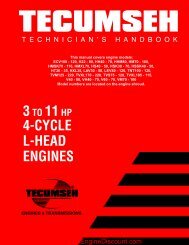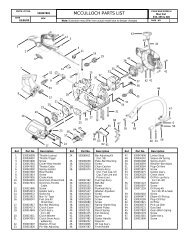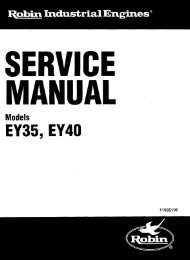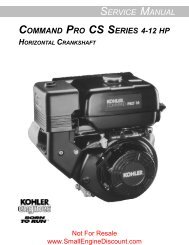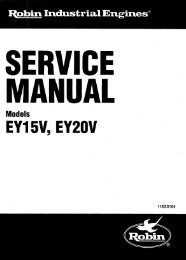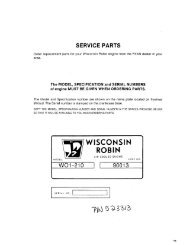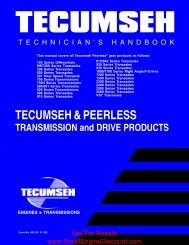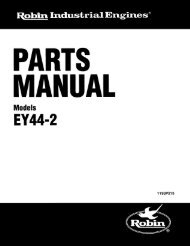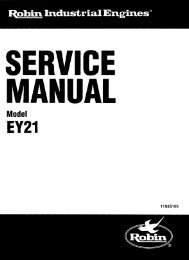4-CYCLE OVERHEAD VALVE ENGINES - Small Engine Discount
4-CYCLE OVERHEAD VALVE ENGINES - Small Engine Discount
4-CYCLE OVERHEAD VALVE ENGINES - Small Engine Discount
Create successful ePaper yourself
Turn your PDF publications into a flip-book with our unique Google optimized e-Paper software.
Mechanical Compression Release (MCR) camshafts<br />
have a pin located in the camshaft, that extends above<br />
the intake or exhaust cam lobe, to lift the valve to<br />
relieve the engine compression for easier cranking.<br />
When the engine starts, centrifugal force moves the<br />
weight outward and the pin will drop back down. The<br />
engine will now run at full compression (diag. 38).<br />
Some OHH engines use a composite camshaft. This<br />
camshaft is used on OHH/OHSK 50-70 engines that<br />
have been manufactured after DOM (date of<br />
manufacture) 7048. This change that took place in<br />
February of 1997 and is basic on the OHH engines,<br />
except those units that use extended camshafts which<br />
will continue to use a cast iron camshaft. A camshaft<br />
kit replaces the old camshaft and includes<br />
compression release components and two light tension<br />
valve springs. It is CRITICAL that the new valve<br />
springs be installed or lobe damage will occur on the<br />
camshaft.<br />
NOTE: You must install the thrust washer between<br />
the cover and cam to prevent wear.<br />
Some OVRM engines use a ramp compression<br />
release (RCR) system that works with the intake valve.<br />
The ramp is located on the backside of the intake cam<br />
lobe. The ramp delays the intake valve closure,<br />
resulting in lower emissions and reduced compression<br />
for easier pull starting (diag. 39).<br />
Valve Seats<br />
COMPRESSION<br />
RELEASE<br />
INTAKE<br />
CAMSHAFT<br />
INSERT<br />
SPRING<br />
END "A"<br />
COMPRESSION<br />
RELEASE SPRING<br />
Valve seats are not replaceable. If they are burned,<br />
pitted, or distorted they can be regrounded using a<br />
grinding stone or a valve seat cutting tool. Valve seats<br />
are ground to an angle of 46 degrees to a width of<br />
EXHAUST<br />
39<br />
3/64" (1.91 mm).<br />
The recommended procedure to properly cut a valve seat is to use the Neway Valve Cutting System, which<br />
consists of three different cutters. OVRM and OHH engines have a small combustion chamber and require the<br />
use of a special Neway cutter #103 for the 46 and 31 degree combination cutter. The 60 degree cutter is Neway<br />
cutter # 111. The tapered pilots required are; Neway # 100-1/4-1 for the .249" (6.325 mm) exhaust guide, and<br />
Neway #100-1/4 for the .250" (6.35 mm) intake guide. Consult the cutter's complete procedure guide for<br />
additional information.<br />
First, use the 60 degree cutter to clean and narrow the seat from the bottom to the center (diag. 40).<br />
A<br />
THRUST<br />
WASHER<br />
Second, use the 31 degree cutter to clean and narrow the seat from the top toward the center (diag. 41).<br />
Third, use the 46 degree cutter to cut the seat to a width of 3/64" (1.191 mm) (diag. 42). Check the contact area<br />
of a new or reconditioned valve face on a finished valve seat. Using fingers, snap the valve sharply against the<br />
corresponding valve seat and view the line imprinted on the valve face. The contact area or line should be<br />
continuous and appear on the upper 1/3 of the valve face. Re-cut the seat to move the contact area higher or<br />
lower if necessary and recheck the contact area.<br />
B<br />
38<br />
BOTTOM<br />
NARROWING<br />
CUTTER<br />
15 0<br />
TOP NARROWING<br />
CUTTER<br />
46 0<br />
TOP<br />
31<br />
NARROW<br />
0<br />
31 0 SEAT CUTTER<br />
46 0<br />
60 0<br />
SEAT<br />
SEAT<br />
3/64" SEAT<br />
72<br />
BOTTOM<br />
NARROWING<br />
40<br />
41<br />
BOTTOM<br />
NARROW<br />
Not For Resale<br />
www.<strong>Small</strong><strong>Engine</strong><strong>Discount</strong>.com<br />
42




